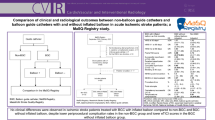Abstract
Introduction
Delayed ischemic neurological deficit associated to cerebral vasospasm is the most common cause of sequelae and death that follows the rupture of an aneurysm. The objective of this study was to evaluate the safety and efficacy of intra-arterial Milrinone in patients with symptomatic refractory cerebral vasospasm.
Patients and Method
Eight patients diagnosed with aneurysmal subarachnoid hemorrhage who developed symptomatic cerebral vasospasm refractory to conventional medical therapy were enrolled. They received an intra-arterial infusion of Milrinone at a rate of 0.25 mg/min, with a total dose of 10–15 mg. Qualitative evaluation of angiographic response, neurological and systemic complications as well as functional outcome at 3 months were documented.
Results
All patients had a significant angiographic response. This was evidenced by a pre-treatment vessel stenosis greater than 70%, that improved to less than 50% after the intra-arterial Milrinone infusion. Three patients developed recurrent vasospasm that improved after a second intra-arterial Milrinone infusion. None of the patients developed neurologic or systemic complications attributed to the intervention. At 3 months follow-up all patients were alive and had a mean modified Rankin scale of 2 ± 1 and a Barthel index of 83 ± 10.
Conclusion
Intra-arterial Milrinone infusion seems to be a safe and effective treatment for patients who develop refractory symptomatic cerebral vasospasm following aneurysmal subarachnoid hemorrhage.


Similar content being viewed by others
References
Lavados P, Sacks C, Prina L, et al. Incidence, 30-day case-fatality rate, and prognosis of stroke in Iquique, Chile: a 2-year community-based prospective study (PISCIS project). Lancet. 2005;365:2206–15.
Wood M, Nowitzke A. Epidemiological aspects of spontaneous subarachnoid haemorrhage in Queensland, Australia. J Clin Neurosci. 2005;12:770–4.
Hop J, Rinkel G, Algra A, van Gijn J. Case-fatality rates and functional outcome after subarachnoid hemorrhage: a systematic review. Stroke. 1997;28:660–4.
Hop J, Rinkel G, Algra A, van Gijn J. Quality of life in patients and partners after aneurysmal sub arachnoid hemorrhage. Stroke. 1998;29:798–804.
Suarez J, Tarr R, Selman W. Aneurysmal subarachnoid hemorrhage. N Engl J Med. 2006;354:387–96.
Dorsch N. Cerebral arterial spasm: a clinical review. Br J Neurosurg. 1995;9:403–12.
Dorsch N. Therapeutic approaches to vasospasm in subarachnoid hemorrhage. Curr Opin Crit Care. 2002;8:128–33.
Solenski NJ, Haley EC Jr, Kassell NF, et al. Medical complications of aneurysmal subarachnoid hemorrhage: a report of the multicenter, cooperative aneurysm study. Crit Care Med. 1995;23: 1007–17.
Claassen J, Bernardini GL, Kreiter K, et al. Effect of cisternal and ventricular blood on risk of delayes cerebral ischemia after subarachnoid hemorrhage: the Fisher scale revisited. Stroke. 2001; 32:2012–20.
Lee KH, Lukovits T, Friedman JA. “Triple-H” therapy for cerebral vasospasm following sub arachnoid hemorrhage. Neurocrit Care. 2006;4:68–76.
Liu JK, Couldwell WT. Intra-arterial papaverine infusions for the treatment of cerebral vasospasm induced by aneurysmal subarachnoid hemorrhage. Neurocrit Care. 2005;2:124–32.
Tseng MY, Czosnyka M, Richards H, et al. Effect of acute treatment with pravastatin on cerebral vasospasm, autoregulation, and delayed ischemic deficits after aneurysmal subarachnoid hemorrhage: a phase II randomized placebo-controlled trial. Stroke. 2005;36:1627–32.
Van den Bergh WM. Magnesium sulfate in aneurysmal subarachnoid hemorrhage: a randomized controlled trial. Stroke. 2005;36:1011–5.
Dorhout Mees SM, Rinkel GJ, Hop JW, et al. Antiplatelet therapy in aneurysmal subarachnoid hemorrhage: a systematic review. Stroke. 2003;34:2285–9.
Wurm G, Tomancok B, Nussbaumer K, et al. Reduction of ischemic sequelae following spontaneous subarachnoid hemorrhage: a double-blind, randomized comparison of enoxaparin versus placebo. Clin Neurol Neurosug. 2004;106:97–103.
Hamada J, Kai J, Morioka M, et al. Effect on cerebral vasospasm of coil embolization followed by microcatheter intrathecal urokinase infusion into the cisterna magna. A prospective randomized study. Stroke. 2003;34:2549–54.
Givertz M, Hare J, Loh E, et al. Effect of bolus milrinone on hemodynamic variables and pulmonary vascular resistance in patients with severe left ventricular dysfunction: a rapid test for reversibility of pulmonary hypertension. J Am Coll Cardiol. 1996;28:1775–80.
Anderson JL, Baim DS, Fein SA, et al. Efficacy and safety of sustained (48 hour) intravenous infusion of milrinone in patients with severe congestive heart failure: a multicenter study. J Am Coll Cardiol. 1987;9:711–22.
Bayram M, De Luca L, Massie MB, et al. Reassessment of dobutamine, dopamine and milrinone in the management of acute heart failure syndromes. Am J Cardiol. 2005;96(Suppl):47G–58G.
Arakawa Y, Kikuta K, Hojo M, et al. Milrinone for the treatment of cerebral vasospasm after subarachnoid hemorrhage: report of seven cases. Neurosurgery. 2001;48:723–30.
Arakawa Y, Kikuta K, Hojo M, et al. Milrinone reduces cerebral vasospasm after subarachnoid hemorrhage grade IV or V. Neurol Med Chir (Tokio). 2004;44:393–401.
Lindegaard K, Normes H, Bakke S, et al. Cerebral vasospasm after subarachnoid hemorrhage investigated by means of transcranial doppler ultrasound. Acta Neurochir Suppl (Wien). 1988;42:81–4.
Soustiel J, Shik V, Shreiber R, et al. Basilar vasospasm diagnosis. Investigation of a modified “Lindegaard Index” based on imaging studies and blood velocity measurements of basilar artery. Stroke. 2002;33:72–8.
Hansen-Schwartz J. Cerebral vasospasm. A consideration of the various cellular mechanism involved in the pathophysiology. Neurocrit Care. 2004;1:235–46.
Dorsch NW. A review of cerebral vasospasm in aneurismal subarachnoid hemorrhage. Part II: management. J Clin Neurosci. 1994;1:78–92.
Polin RS, Hansen CA, German P, et al. Intra-arterially administered papaverine for the treatment of symptomatic cerebral vasospasm. Neurosurgery. 1998;42:1256–67.
Kassell NF, Helm G, Simmons N, et al. Treatment of cerebral vasospasm with intra-arterial papaverine. J Neurosurg. 1992;77:848–52.
Yoshida K, Watanabe H, Nakamura S. Intra-arterial injection of amrinone for vasospasm induced by subarachnoid hemorrhage. Am J Neuroradiol. 1997;18:492–6.
Khajavi K, Ayzman I, Shearer D, et al. Prevention of chronic cerebral vasospasm in dogs with milrinone. Neurosurgery. 1997;40:354–62.
Linn FH, Rinkel GJ, Algra A, van Gijn J. Incidence of subarachnoid hemorrhage: role of region, year, and rate of computed tomography: a meta-analysis. Stroke. 1996;27:625–9.
Lambert G, Naredi S, Edén E, et al. Monoamine metabolism and sympathetic nervous activation following subarachnoid haemorrhage: influence of gender and hydrocephalus. Brain Res Bull. 2002;58:77–82.
Author information
Authors and Affiliations
Corresponding author
Rights and permissions
About this article
Cite this article
Romero, C.M., Morales, D., Reccius, A. et al. Milrinone as a Rescue Therapy for Symptomatic Refractory Cerebral Vasospasm in Aneurysmal Subarachnoid Hemorrhage. Neurocrit Care 11, 165–171 (2009). https://doi.org/10.1007/s12028-008-9048-0
Published:
Issue Date:
DOI: https://doi.org/10.1007/s12028-008-9048-0




